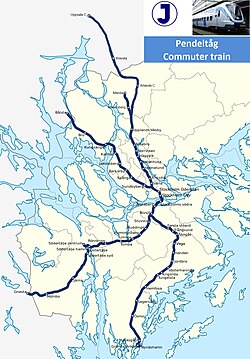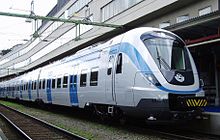Pendeltåg (Stockholm)
|
|
|
|---|---|
| Gauge : | 1435 mm ( standard gauge ) |
| Power system : | 15 kV, 16.7 Hz ~ |
Stockholms pendeltåg is a suburban train system in Stockholm in Sweden that is comparable to the S-Bahn in Frankfurt am Main , Stuttgart and Munich , whereby the tracks of long-distance traffic are partly used. Most of the trains run on two lines in the province of Stockholm County . Three terminus, Uppsala , Bålsta and Gnesta , are in the provinces of Uppsala län and Södermanland län . During the day the trains run every quarter of an hour and in the evening every half hour. A few additional trains run during the weekday rush hour mornings and evenings. There are a total of 53 stations on the entire route network.
The traffic runs over the tracks of Trafikverket and is operated by AB Storstockholms Lokaltrafik , SL for short. SL provides the vehicles, the operation is tendered to private companies. Citypendeln was the operator until June 2006 , after which Stockholmståg took over the traffic. Stockholmståg won the new tender in 2005 after city commuting meant that it could not operate satisfactorily. Stockholmståg is a subsidiary of the Swedish state railway Statens Järnvägar .
history
As early as the end of the 19th century, there was rail-based local public transport in Stockholm. This was operated by SJ and other railway companies. In the 1960s, SJ wanted to give up local transport for cost reasons. The city of Stockholm and Stockholm County (to which Stockholm was not yet part) agreed that SL should take over all local rail transport in Stockholm County in the future. SL now determined fares and transport offers, while SJ continued to provide the track systems as well as trains and personnel for SL. The transport system should be expanded and operated “underground like”. The stations were expanded and new train units purchased. The first trains of the X1 series were officially used in May 1968 and initially referred to as "SL förortståg" (SL suburban train) and then as "SL lokaltåg" (SL local train), before the name Pendeltåg was officially used for the first time in the early 1980s has been used.
Initially, the Pendeltåg trains ran on the same tracks as the rest of the SJ freight and long-distance traffic. Capacity bottlenecks soon became noticeable and it was decided to build separate tracks for suburban traffic on the most frequented routes. In the places where the number of tracks was doubled from two to four, the suburban trains were to use the inner tracks. The rest of the traffic should be routed over the outer tracks. The first four-track section was put into operation in 1972 between Årstabron and Älvsjö . Further four-lane sections were built between 1986 and 1996.
The next extensions to the suburban train network were the Kungsängen - Bålsta line , which opened in August 2001, and the Årstaberg stop , which opened in January 2006. In addition, the Västerhaninge - Tungelsta and Södertälje centrum - Södertälje hamn sections were expanded to two tracks.
In December 2012, a new line between Älvsjö and Uppsala via Upplands Väsby and Stockholm / Arlanda Airport went into operation. On the route between Uppsala and Upplands-Väsby, it replaces the corresponding line of the UL transport association (Upptåget) of neighboring Uppsala län.
Until mid-2017, the suburban trains in central Stockholm had to share the tracks with the freight and long-distance traffic, which led to a high susceptibility to delays. The Citybana , a double-track tunnel with two new train stations under the city center, which is only used by suburban trains, helped here . As a result, suburban traffic now has its own tracks between Järna or Nynäshamn and Upplands Väsby .
On the branch to Bålsta , separate tracks have been built to Kallhäll since the end of 2012 . The Barkarby – Kallhäll section and two additional bridges at Tomteboda were completed at the end of 2016, while Spånga – Barkarby is under construction. The remaining section Tomteboda – Spånga will not be completed until 2028, because Sundbyberg station is to be lowered in this context.
Since December 10th 2017 there are new lines with new numbers. The so-called Snabbtåg (with an X in the line name) were introduced, which do not stop at all stations.
Lines
| line | old number | route | Travel time | length | Stations |
|---|---|---|---|---|---|
| J40 | J38 (to Älvsjö) |
Uppsala - Södertälje centrum | 1:41 h | 25th | |
| J41 J41X |
J36 |
Märsta - Södertälje centrum Märsta - Tumba |
1:24 h 1:00 h |
74 km |
24 20 |
| J42X | - |
Märsta - Nynäshamn Märsta - Älvsjö |
1:27 h 0:41 h |
||
| J43 J43X |
J35 |
Bålsta - Nynäshamn Kallhäll - Nynäshamn |
1:42 h 1:22 h |
107 km |
28 25 |
| J48 | J37 | Södertälje centrum - Gnesta | 0:24 h | 30 km | 6th |
The express line 43X does not stop at Trångsund, Skogås and Krigslida, 42X also does not stop at Rotebro, Norrviken, Häggvik and Ulriksdal, analogous to line 41X.
Another line with the number 44 has been planned since December 2017, but has not yet been set up.
On the Märsta – Södertälje and Kungsängen – Västerhaninge routes, there are half-hourly trains between 5 a.m. and 1 a.m., with an additional 15-minute service during the day. During rush hour there are also a few additional trains between Tumba and Jakobsberg or Nynäshamn and Upplands-Väsby, which then run every 7½ minutes. The Södertälje Gnesta line, on the other hand, runs every half hour during rush hour and with up to two hours between trains during the rest of the time. In the summer months there is thin traffic on all routes.
Pendeltåg are operated by type X60 electric cars . The trains can be linked together to form a maximum of 214-meter-long units that can accommodate 1,800 passengers, 750 of which have seats. The maximum speed is 160 km / h and can be reached with the modern railcars on the routes north of Kallhäll and north of Rotebro and south of Järna. On the rest of the network, the speed between the stations is usually between 80 and 140 km / h. The average speed including stops at the train station is around 60 km / h.
Train stations
There are 53 stops in the Pendeltågnetz and most of these stops have a central platform and one or two entrances with ticket controls. Some transfer stations have several platforms. There are no ticket controls at the stations on the Södertälje – Gnesta and Krigslida – Nynäshamn routes. Instead, tickets are sold and checked on the trains.
In Stockholm City, Flemingsberg, Södertälje Syd, Gnesta, Sundbyberg, Bålsta, Arlanda and Uppsala there are transfer options for regional and long-distance transport as well as regional transport in Märsta and Knivsta. In Stockholm City, Stockholm Odenplan, Sundbyberg and Farsta Strand there are transition options to the subway network; in Årstaberg, Sundbyberg, Solna and (from 2023) Helenelund to Tvärbanan .
Although the trains are a maximum of 214 meters long, the longest platform is 320 meters long, making it the longest platform in all of Stockholm's local traffic. It is located in the Handen station. It was built long enough to bridge the distance between the two exits.
The two stations Stockholm City and Odenplan have platform screen doors . The driver must stop at the designated place to within 75 cm so that train doors and platform screen doors can open in the same place.
Passengers
Every day around 325,000 trips are made with the Pendeltåg. In total, more than 5.8 million passenger kilometers are covered with the Pendeltåg on a normal (winter) working day. The ten most popular train stations (number of passengers boarding Pendeltåg on a winter working day in 2016):
| # | Breakpoint | Number of boarding passengers |
|---|---|---|
| 1. | Stockholm C | 64 200 |
| 2. | Stockholm's södra | 17 100 |
| 3. | Karlberg | 15 900 |
| 4th | Älvsjö | 15 100 |
| 5. | Solna | 13 500 |
| 6th | Flemingsberg | 11 700 |
| 7th | Sundbyberg | 11 300 |
| 8th. | Sollentuna | 11,000 |
| 9. | Årstaberg | 10 600 |
| 10. | Jakobsberg | 9 200 |
| . | ||
| 53. | Hemfosa | 100 |
Car types

In operation:
- SL X60 (2005–)
No longer in operation:
- X10 (1982-2017)
- X20 / X23 (2001-2002)
- Bn (2001-2003), "dansktåg" (Danish train)
- X420 (2002-2005), "tysktåg" (German train)
- X1 (1967-2011)
Depots
The trains have been serviced in the Älvsjö depot since 1968. In 2006 a depot in Upplands-Bro was opened and in 2009 another one in Södertälje-Hamn followed. Some trains are parked at the Kungsängen, Märsta, Sundbyberg, Västerhaninge and Tumba stations.
swell
- ↑ Trafikverket: Mälarbanan (Swedish)
- ↑ SL timetables
- ↑ SLL: Grönt ljus för pendeltågen 2018
- ↑ Försenad start för en av nya pendeltågslinjerna ( Memento of the original from April 5, 2018 in the Internet Archive ) Info: The archive link was inserted automatically and has not yet been checked. Please check the original and archive link according to the instructions and then remove this notice.
- ↑ Nya tåglinjen skjuts upp igen
- ^ Metro October 13, 2008, SL advertising. Haninge Center
- ↑ Påstigande vintervardag 2016 ( Memento of the original from December 25, 2017 in the Internet Archive ) Info: The archive link was inserted automatically and has not yet been checked. Please check the original and archive link according to the instructions and then remove this notice. (PDF; 11 MB)
- ↑ SL Annual Report 2009 (Swedish, PDF; 3.4 MB). Archived from the original on September 7, 2010 ; Retrieved February 5, 2015 .
Web links
- Homepage of AB Storstockholms Lokaltrafik . Retrieved January 17, 2018 (Swedish).
- Line network of all city and suburban railways. (PDF) Retrieved January 17, 2018 (Swedish).


